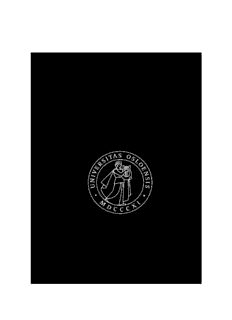
Gertrude Stein's The Autobiography of Alice B. Toklas PDF
Preview Gertrude Stein's The Autobiography of Alice B. Toklas
Autobiographical Displacements The Elusive Subject and the Figure of the Author in Gertrude Stein’s The Autobiography of Alice B. Toklas and Theresa Hak Kyung Cha’s Dictee Nina Engebak Yardley A Thesis Presented to The Department of Literature, Area Studies and European Languages University of Oslo in Partial Fulfilment of the Requirements for the MA Degree Spring 2013 II Autobiographical Displacements The Elusive Subject and the Figure of the Author in Gertrude Stein’s The Autobiography of Alice B. Toklas and Theresa Hak Kyung Cha’s Dictee Nina Engebak Yardley III © Nina Engebak Yardley 2013 Autobiographical Displacements: The Elusive Subject and the Figure of the Author in Gertrude Stein’s The Autobiography of Alice B. Toklas and Theresa Hak Kyung Cha’s Dictee Nina Engebak Yardley http://www.duo.uio.no/ Trykk: Reprosentralen, Universitetet i Oslo IV Abstract This thesis explores conceptions of authorship and the representation of the author-figure in Gertrude Stein's The Autobiography of Alice B. Toklas (1933) and Theresa Hak Kyung Cha's Dictee (1982). It focuses on the structural complexity of these textual self-figurations that, in distinct yet arguably related ways, fuse fact and fiction and signify the self through the trope of autobiographical displacement. The close-readings aim to uncover how these experimentations with form both allow a certain degree of self-exposure and simultaneously divert attention from the author-figure characteristic of traditional depictions of the writing self. My argument is that these texts engage with canonized autobiography, and that Stein and Cha’s generic subversions in effect problematize the underlying mechanisms of normative autobiographical narration. The contextualized juxtaposition further illustrates certain instrumental theoretical developments within the field of life-writing in general and feminist contributions to autobiography theory in particular. V VI Acknowledgements First, I want to thank my supervisor, Associate Professor Rebecca Lynne Scherr, for her patience, constructive criticism, and for showing confidence in my project throughout. I am thankful to Liv Christina Varen for her unwavering friendship, our engaging discussions over the years, literary and otherwise, and for giving invaluable feedback on the early drafts. I am also indebted to Sofie Møller, who introduced me to postmodern theory, and whose enthusiasm got me going academically as an Erasmus undergraduate student in Leeds. I would like to give a general thanks to my dear real-life friends for patiently listening to my ramblings about my fictional ones. I owe much to my teachers at the University of Oslo for their inspiration and encouragement – it has been illuminating. Thank you. Thanks are also owed to the librarians at the University Library, who have been most helpful. Last, I am grateful to my parents, James Douglas Yardley and Berit Engebak, who first introduced me the joys of literature. VII VIII Contents Introduction ................................................................................................................................ 1 Gertrude Stein and The Autobiography of Alice B. Toklas (1933) ......................................... 3 Theresa Hak Kyung Cha and Dictee (1982) .......................................................................... 3 Theoretical framework and methodology .............................................................................. 4 Chapter outline ..................................................................................................................... 12 1 Rhetorical Third-Personality: Gertrude Stein’s The Autobiography of Alice B. Toklas .. 13 1.1 Writing Other, writing Self: “Gertrice/Altrude” and authorial authority .................. 19 1.2 The discourse of genius: the question of authorial autonomy ................................... 26 1.3 Coda: Identity and Entity, and autobiographic self-objectification ........................... 34 2 The Rhetoric of Apparent Authorial Absence: Theresa Hak Kyung Cha’s Dictee ......... 43 2.1 The role of history, national identity, language, and the figure of the mother .......... 47 2.2 Mythological subjectivities and the rewriting of ancient myths ................................ 53 2.3 Autobiographical retrospection and the act of observation ....................................... 58 2.4 On representation: the act of writing and History re-presented ................................. 62 2.5 Coda: the implied autobiographer and the politics of authorship .............................. 72 3 The Elusive Subject as Seen From the Outside: A Comparative Analysis ...................... 75 3.1 Seen from the outside: autobiographical objectification as formal devise ................ 79 3.2 The problem of identity: the role of language, and the elusive subject ..................... 85 3.3 Relational autobiography and feminist aspects ......................................................... 89 Conclusion ................................................................................................................................ 96 Works Cited .............................................................................................................................. 99 IX X
Description: